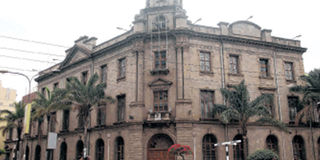Khoja Mosque lit city’s night skyline in 1920s

Khoja Mosque was built from January 1920 and was officially opened in January 1922. File | DAILY NATION
What you need to know:
- In the colonial days, this location was the axis of the old city centre. It was the confluence of Government Road, Indian Bazaar Street, Hardinge Street (Kimathi Street), and Victoria Street (Tom Mboya Street).
- The historical and economic factors relating to this period were not favourable either. The First World War had just ended in 1919. It must have drained the colonial treasury. The Kenya-Uganda railway that was the mainstay of the colonial economy had only been completed around 1902.
It was in early 1964. The independence decoration banners, displayed in the colours of the new flag of Kenya, were prominent outside the Jamatkhana on Government Road. I was a young boy then, and we had just moved to Nairobi.
The memory of my first encounter with the Jamatkhana (congregational house) is still vivid because it became my family’s prayer venue for 10 years before we migrated to Canada.
The Jamatkhana was commonly referred to as the “Khoja Mosque” by the public. The majesty of the building would be accentuated in the evenings when the many light bulbs on its exterior walls would be switched on, especially on festive occasions.
The building would be like an illuminated palace in Nairobi’s night skyline. It was prominently featured in a 1962 documentary about the Aga Khan, titled The Living Camera.
Produced by Drew and Associates, the film contained a footage of the building as well as a highly charged and emotional recitation by the Ismaili congregation inside the prayer hall.
The Jamatkhana’s location at the corner of the old Government Road (now Moi Avenue) and River Road and right across the old Indian Bazaar Street (now Biashara Street) must have been strategic.
In the colonial days, this location was the axis of the old city centre. It was the confluence of Government Road, Indian Bazaar Street, Hardinge Street (Kimathi Street), and Victoria Street (Tom Mboya Street).
Not to be lost is the fact that the Daily Nation newspaper, established in 1960, was first situated in the premises of a former bakery on Victoria Street, at a very short walk from the Jamatkhana.
From the foundation stone plaque, the impressive building was constructed from January 1920 and was officially opened in January 1922. Its completion within two years must have been an engineering and construction feat at that time, considering the equipments then.
It should also be noted that the Ismaili community, mostly migrants from the Kutch-Kathiawar area of present day State of Gujarat in India, had only settled in large numbers in colonial Kenya for approximately 20 years. Their population could not have been very large then.
The historical and economic factors relating to this period were not favourable either. The First World War had just ended in 1919. It must have drained the colonial treasury. The Kenya-Uganda railway that was the mainstay of the colonial economy had only been completed around 1902.
Therefore, for a newly established community, to have constructed such a prominent building was an impressive accomplishment.
From a traditional perspective, the Ismaili Imamat and the Ismaili community have always placed importance on supporting the establishment and creation of Jamatkhanas wherever they have settled.
Hence the contributions made by members of the community played an important role in building Khoja Mosque. The names of the major donors are inscribed on the plaque marking the opening ceremony.
Zahir Dharsee grew up in East Africa and lives in Toronto, Canada




